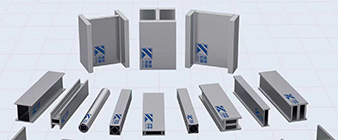When comparing high-strength S690 steel to S960 steel, several key properties and characteristics come into play. Here is a detailed comparison:
Yield Strength
S690 steel: minimum yield strength is 690 MPa.
S960 steel: minimum yield strength 960 MPa.
Significance: S960 steel has significantly higher strength, allowing for lighter structures and greater load-bearing capacity.
Tensile Strength
S690 steel: Tensile strength typically 780 to 900 MPa.
S960 steel: tensile strength range from 900 to 1100 MPa.
Significance: S960 steel offers higher tensile strength, making it suitable for more severe applications.
Extensibility
S690 steel: Generally has good ductility and allows certain deformation under stress.
S960 Steel: While still ductile, S960 may elongate less than S690, especially in thicker sections.
Significance: For applications where ductility is critical, design considerations may be necessary.
Weldability
S690 Steel: Due to its higher strength, careful welding practices are required, including preheating and possible post-weld heat treatment.
S960 Steel: Has similar challenges and requires careful welding techniques to prevent problems such as cracks.
Significance: Both materials require attention to the welding process, but S960 can be more challenging due to its higher strength.
Application
S690 steel: Commonly used in buildings, bridges and heavy machinery that require high strength but do not reach the S960 ultimate grade.
S960 Steel: Ideal for high-performance applications including high-rise buildings, heavy-duty structures and parts requiring maximum strength.
Why it matters: The S960 is the first choice for projects that require maximum performance and efficiency.
Cost
S690 Steel: Typically cheaper than S960 due to lower strength requirements.
S960 Steel: Higher costs associated with advanced material properties and processing.
Significance: While the upfront cost of the S960 may be higher, there are savings in material and construction costs due to reduced weight and material usage.
Persistence
Both grades: S690 and S960 are recyclable and contribute to sustainable building practices.
Significance: Using high-strength steel allows for more efficient designs and reduced environmental impact.
S960 steel has superior strength compared to S690 steel, making it suitable for the most demanding applications. However, both materials present challenges in terms of weldability and ductility. The choice between S690 and S960 will depend on specific project requirements, including load conditions, design considerations and cost constraints.
-
2024-9-15 Introduction to the performance of 304/304L stainless steel
-
 2024-9-16 UNS S32304 stainless steel structural performance
2024-9-16 UNS S32304 stainless steel structural performance -
 2024-9-20 1.4404 stainless steel in innovative applications in bridges
2024-9-20 1.4404 stainless steel in innovative applications in bridges -
 2024-7-17 S460 high strength structural steel Sections
2024-7-17 S460 high strength structural steel Sections -
 2024-9-21 S960QH/S960QLH Hollow structural Stations in Hong Kong
2024-9-21 S960QH/S960QLH Hollow structural Stations in Hong Kong -
 2024-9-24 S690 Structural Section-Universal Bearing Piles
2024-9-24 S690 Structural Section-Universal Bearing Piles -
 2024-7-12 Innovative applications of S960 Steel in Construction
2024-7-12 Innovative applications of S960 Steel in Construction



